‘A gift from Scotland’:golf’s early days in Ireland
Published in 18th-19th Century Social Perspectives, 18th–19th - Century History, 20th Century Social Perspectives, 20th-century / Contemporary History, Features, Issue 5 (Sep/Oct 2006), Volume 14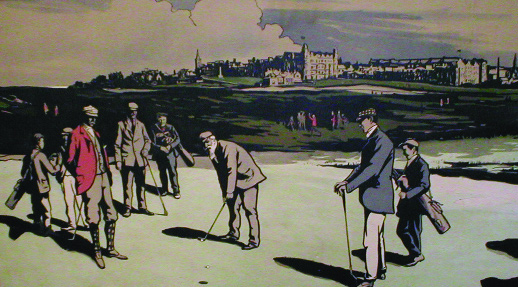
Late nineteenth-century print of St Andrew’s, Scotland.
The history of Irish sport is a neglected realm. There is no general history of sport in Ireland, and reliable histories of individual sports are few and far between. Yet sport contributes a significant strand to modern Irish identity. The annual Irish invasion of Cheltenham for Gold Cup week, the friendly fervour of Ireland’s soccer fans at Italia 1990 and since, the unique atmosphere of the Galway Races, the passion that drives Munster rugby supporters and summers brimful of Gaelic games are just some examples of how sport captures part of the essence of today’s Ireland.
The fact that this year’s Ryder Cup will be played for in September, Ireland’s supreme sporting month, means that it will coincide with the climax of the All-Ireland championships in hurling and Gaelic football. Visitors to Ireland for the Ryder Cup may be struck by the deep passions generated by hurling and football, and by how these differ from the norms of contemporary international sporting culture.
In their steely retention of an amateur ethos, Gaelic games are true to their late Victorian origins and occupy a different sporting universe from Europe’s bi-annual golfing contest against the United States. Support for hurling and Gaelic football springs from reservoirs of local and national sentiment that may be peculiar to Ireland. The special place that Gaelic games occupy in Irish life derives in part from the significance of the Gaelic Athletic Association (GAA) in the development of modern Irish nationalism.
Golf and Gaelic games as sporting contemporaries
While late nineteenth-century Irish sporting history is synonymous with the emergence of the GAA, this was also the time when golf began to make serious inroads in Ireland. Rugby and cricket were the first organised sports to take off in Ireland, and the inaugural international rugby match was played against England as early as 1875. The Irish Rugby Football Union already had 77 affiliated clubs when it was founded in 1879. Michael Cusack, who helped found the GAA, was a keen athlete, cricketer and rugby player before those sports’ élitism encouraged him to turn his hand to reviving Ireland’s native games.
The GAA was founded in 1884 while the Golfing Union of Ireland traces its history back to 1891, which makes it the world’s oldest golfing body. When, in W. B. Yeats’s words, ‘a disillusioned and embittered Ireland turned from parliamentary politics’ after the fall of Parnell in 1891, quite a number of Irish men and women all over the country, especially from the professional classes, seem to have become obsessed with golf.
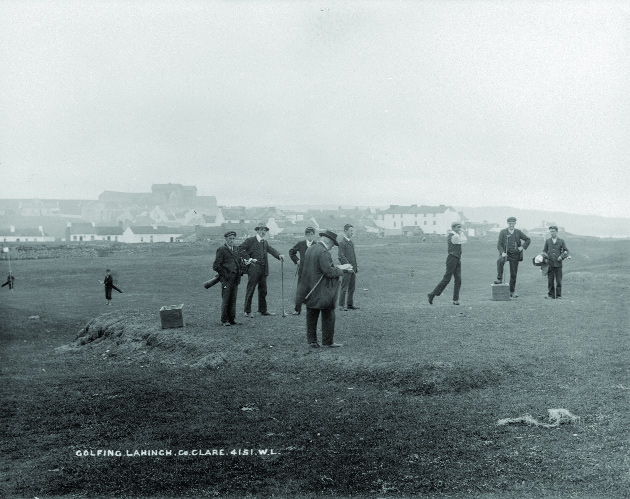
Alexander Shaw (centre), a director of the Waterford, Limerick and Western Railway, was active in the Irish Industrial Movement and helped found Lahinch Golf Club, pictured here in the early twentieth century. (National Photographic Archive)
The late Victorian period witnessed the codification of those sports—football, rugby, tennis and golf—that retain their popularity to this day. They took root in Ireland not long after their emergence in Britain. This underlines the extent to which life in late nineteenth-century Ireland often mirrored what was happening in the neighbouring island. The popularity of ‘English games’ was viewed as threatening by those who saw the cultivation and preservation of a distinctive Irish identity as a political priority. The abrasive Irish Irelander D. P. Moran saw imported games as ‘powerful Anglicisers’, and in The Leader he regularly rebuked the élite Irish colleges for promoting rugby and cricket while neglecting Gaelic games.
The golfing ’90s
While golf may have been played in Bray, Co. Wicklow, as early as 1762, the game came into its own in the last two decades of the nineteenth century. The first Irish golf clubs were founded in the 1880s, mainly in Ulster and in the Dublin area. Although golf was played by officers stationed at the Curragh from the 1850s onwards, the Royal Belfast Club blazed the trail for Irish golf when it was established in 1881 by George Baillie, a Scottish teacher working in Belfast.
Golf in Ireland has been described as ‘a gift from Scotland’, and there is ample evidence of this Scottish connection. Many early clubs imported Scottish professionals to teach the game to its Irish enthusiasts. In 1904 a writer in The Leader admits to having played ‘Scotch golf’ and, indeed, the game’s origins in a fellow Celtic country may have helped it to avoid the stigma attached to other imported sports in nationalist minds.
In the early 1880s a few holes were laid out in the Phoenix Park, where Arthur Balfour played under police protection during his controversial spell as chief secretary. At one point the course was dug up by Land League supporters, and this led to the formation in 1885 of the Royal Dublin Golf Club, whose founding father was a Scottish banker, John Lumsden. Just three years later the Cork Golf Club became the first to be set up in Munster. Golf arrived in Connacht in 1894, when a club was established at Rosses Point, Sligo. The Irish Open Amateur Golf Championship was first played in 1892, while the Irish Ladies Championship came into being just two years later. The South of Ireland Championship was being played as early as 1895.
The 1890s, which were a difficult time for the GAA in the wake of the Parnell split, turned out to be a boom time for golf. During that decade golf clubs sprouted all over the country. Some 103 golf clubs came into existence in the space of a decade. As early as 1900 Ireland had a dedicated golf magazine, The Irish Golfer, whose pages chronicle the exploits of early golfing enthusiasts. By 1901 there were an estimated 12,000 golfers in Ireland. Until recent years no subsequent decade had seen such frenetic activity as the 1890s in the formation of golf clubs. Sixty-eight new clubs made their appearance in the opening decade of the twentieth century. By 1914 Ireland had 190 golf clubs, just under half of the number that exist today. Even in the prosperous 1960s a mere sixteen new clubs were founded.
The impressive spread of golf in Ireland in the 1890s can be attributed to the country’s more settled condition following the agrarian and political upheavals of the Parnell era during the preceding decade. The game’s development was also a reflection of the increasing prosperity of late Victorian Ireland and the growth of a leisured professional class. The prominence of bank managers on early golf club committees tells its own story. In 1901 The Irish Golfer lauded the ‘good fellowship, the freemasonry of golf’, and observed that the game had been ‘a great boon to many neighbourhoods which were once devoid of amusements’.
Some early clubs
A native of Edinburgh, W. C. Pickeman, inspired the creation of one of Ireland’s leading clubs at Portmarnock, Co. Dublin. Pickeman spotted Portmarnock’s golfing potential when he visited the peninsula on Christmas Eve 1893. By the following October, he and some associates had secured a 25-year lease from the local landlord, John Jameson, owner of the famous distillery, who became the club’s first president. The Portmarnock course was laid out by the club’s first professional, Mungo Park of Musselburgh in Scotland, who had won the Open Championship on his home course in 1874.
Limerick Golf Club provides a good insight into Ireland’s early golfing history. The driving force in the club’s early days was Alexander Shaw, a local businessman, who owned a bacon factory and was a director of the Waterford, Limerick and Western Railway. Shaw was heavily involved in the Irish Industrial Movement, which strove to promote economic development in early twentieth-century Ireland. He published books on trade and Irish canals and went on to help found Lahinch Golf Club. Shaw’s firm was a regular advertiser in The Leader and was praised by D. P. Moran as an example of an enterprising Irish company.
The Limerick club’s early years were a considerable struggle. Members played just one day each week between October and March on land rented from a local farmer. This was a common feature of the early history of inland courses. In summer the grass was too long, and enthusiasts either turned to other sporting activities or played at seaside courses. In the summer months Limerick golf migrated to the seaside resort of Lahinch.
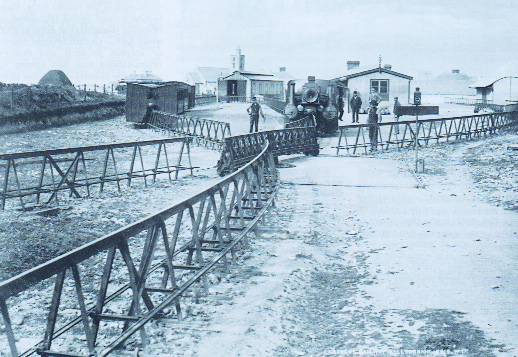
The Lartigue railway in north Kerry paid part of the cost for the development of Ballybunion Golf Club. (National Library of Ireland)
The emergence of Sligo Golf Club at Rosses Point was inspired by Lt Col James Campbell of the Sligo militia. Campbell was a prominent local businessman, involved in the Sligo Steam Navigation Company, in the local railway venture and the harbour commissioners. He was a board member of the Ulster Bank, high sheriff of Sligo and master of the local hunt. Another founding father of golf at Rosses Point was Arthur Jackson, who ran the Pollexfen family business and married the youngest Pollexfen, who was an aunt to both W. B. and Jack B. Yeats. Jackson later entered the first independent Irish senate, where he sat for six years alongside his wife’s nephew.
Railways and the spread of golf
It has been said that ‘railways unleashed a passion for travel’ in the second half of the nineteenth century. Their existence, as well as the immense popularity of the bicycle, also facilitated the spread of golf. Golfing travellers were assiduously courted by the railway companies with offers of specially reduced fares. In 1893 the Tramore railway was offering first-class return golf tickets at one shilling apiece.
The Northern Counties’ Railway was instrumental in the development of golf at Portrush, where the stationmaster would often hold back the Belfast train to accommodate returning golfers.
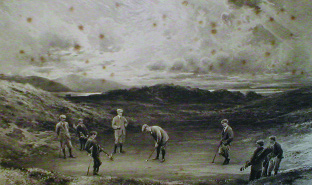
Golf’s origins in a fellow Celtic country may have helped it to avoid the stigma attached to other imported sports in nationalist minds.
The Belfast and County Down Railway played a key role in the emergence of the famous club that is now Royal County Down. Its railway station doubled as a golf clubhouse for a time. The Great Northern Railway (GNR) styled itself as ‘the line for the golf links’, boasting in 1910 that it served ten eighteen-hole courses and eighteen nine-hole ones. The GNR owned the golf-course at Bundoran, adjacent to its hotel. The Lartigue railway in North Kerry paid part of the cost of the development of Ballybunion Golf Club.
Golf and the Anglo-Irish community
The Island Golf Club in County Dublin traces its history to a day in 1887 when four golfing enthusiasts rowed out to the area where this old links is still located. Their professions—a brewery proprietor, a solicitor and two bankers—reveal much about the socio-economic backgrounds of those who pioneered golf in late Victorian Ireland. All were already members of the Royal Dublin Golf Club but wanted to found a club specifically for civilians. The club had ten founding members, who continued to exercise a controlling influence until their deaths.
The author Brian Inglis, whose grandfather was one of its founders, has given a poignant description of the Island Golf Club’s importance to the Protestant community in Malahide. He describes it as ‘the only local institution which rivalled the church as a social power’. It was not plain sailing for Church of Ireland golfers, as playing on Sundays was frowned upon by the local rector, who viewed the Island club as an occasion of sin for his parishioners.
In his autobiography, West Briton, Brian Inglis explains the club’s appeal. The members ‘were all our set; which meant, other things being equal, that families “in trade” and Roman Catholics were excluded’. It was not only religion that mattered in determining eligibility. Inglis records that the local merchant, although a Protestant and regular churchgoer, could not become a member, even when one of his daughters became captain of the ladies’ team at Trinity College! In practice, ‘no retailer could become a member of the club unless of an impeccable social background’. It is tempting to see Ireland’s golf clubs as places to which the Anglo-Irish élite retreated in the decades following the fall of Parnell to enjoy a final belle époque before war and revolution brought their long period of social ascendancy to an end.
Women golfers
Another early arrival on the Irish golfing scene, Malahide Golf Club, had a very distinguished founder. Nathaniel Hone the Younger was one of Ireland’s leading late nineteenth-century painters. He was also captain of the club from 1892 to 1897, having founded it with his brother-in-law. The Malahide Club illustrates an interesting feature of golf in its formative years: the relative equality between men and women. In Malahide, women paid the same entry fee (£2) and annual subscription (£1).
The early development of women’s golf is highlighted by the fact that the Irish Ladies Golfing Union was founded in 1893, just two years after its male counterpart and in the same year as its English equivalent. Irish women golfers achieved success before their male counterparts. Ireland was represented among the 38 entrants at the first British Ladies Amateur Championship played in 1893. Between 1899 and 1907 two Irish women, May Hezlet and Rhona Adair, won a total of five championships.
The Great War and the royal game
The outbreak of the First World War had a dramatic effect on the game of golf in Ireland. Many keen golfers volunteered for military service, some never to return. In Greystones, Co. Wicklow, twenty per cent of the club’s membership went to the front, with similar percentages going from clubs at Galway and Stillorgan. The Bar Golfing Society, whose membership was confined to judges and members of the Law Library, had 30 of its 120 members on active service. In 1916 the County Down Club had the largest contingent of serving golfers (107), followed by Portmarnock (70), the Island (46) and Foxrock (38). These numbers are impressive when it is considered that most clubs at the time had quite small memberships. In March 1915 there were some 1,250 Irish golfers serving at the front.
Clubs also raised substantial funds for the war effort, £200 from the Castle and £95 from Woodenbridge. As a result of the war, a number of clubs closed either temporarily or permanently, and club competitions were often abandoned. The Royal Dublin links at Bull Island became a rifle range and the club’s members were given temporary membership of Portmarnock for the duration of the war. The links were commandeered once again by the Irish army during the Civil War but were soon returned to the golfing fraternity.
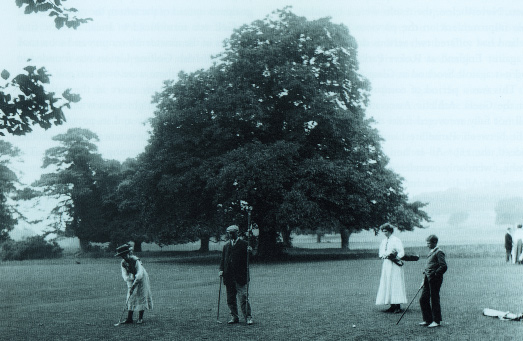
Women playing golf at Delgany, Co. Wicklow. The early development of women’s golf is highlighted by the fact that the Irish Ladies Golfing Union was founded in 1893. (National Library of Ireland)
Was golf a ‘foreign game’?
Such was the success of golf in its early years that in 1910 W. C. Pickeman expressed the view that ‘golf is spreading so rapidly all over Ireland that it may in a few years time become the national game’. That was never a realistic proposition, given the narrow social stratum from which early golfers were drawn. A rare golfing priest, Revd Alphonsus J. Ryan (a graduate of Belvedere College and Maynooth and a four handicap player), even argued that ‘golf is really an Irish and not a Scotch game’. In a standard history of golf published in 1955, Robert Browning even suggested that the legendary Cúchulainn might have played golf rather than hurling!
It is difficult to know precisely what Irish nationalists thought about the newly arrived game of golf. The Leader, which epitomised the Irish Ireland philosophy of that period and often fulminated against the Anglicising impact of cricket, soccer, rugby and hockey, rarely mentioned golf, despite the fact that British regiments had played a big part in bringing the game to Ireland.
One prominent nationalist, C. S. Andrews, reflecting on early twentieth-century nationalist culture, outlined its puritanical ethos, disapproving of drink, formal clothes, horse-racing, golf and tennis. A verse published in the journal Gaelic Ireland early in the twentieth century is quite revealing:
‘Each foreign game we now disdain
Golf, cricket and ping-pong
Rugby and soccer in our midst
Have flourished for too long
Time to name each Irish game
We’ll pride in and we’ll play’.
On the other hand, in the GAA’s rulebook golf was never designated a ‘foreign game’.
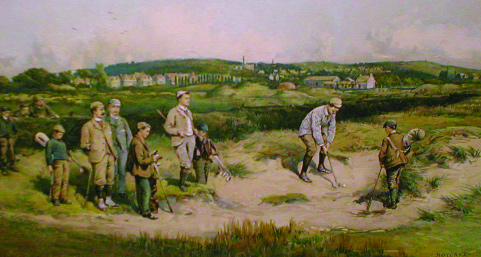
This early twentieth-century print indicates that golf was clearly popular amongst all age groups.
Conclusion
Given their association with Ireland’s social and political élite, golf clubs inevitably had a difficult time during the War of Independence and the ensuing Civil War. A number of clubhouses were burned down and competitions were disrupted. The role played by sport in binding up the wounds of a decade of conflict was noteworthy and may have been underrated. Given its deep entanglement with nationalist politics, it was an achievement for the GAA to hold together in the face of deep Civil War divisions. After independence, rugby remained united and continues to provide a common sporting cause for northern unionists and southern nationalists. The Golfing Union of Ireland continues to run golf throughout the island of Ireland. Sport has also maintained positive linkages between Britain and Ireland—the British and Irish Lions in rugby and the Ryder Cup in golf—at times when Anglo-Irish relations may have been fraught.
The Tailteann Games, a revival of an ancient Irish tradition, were conceived by the Irish Free State’s first minister for posts and telegraphs, J. J. Walsh, as a means of drawing the Irish people together at a time of turmoil and division. The first games were originally planned for August 1922 but had to be deferred until 1924 on account of the outbreak of the Civil War. Golf was included, despite the misgivings of some GAA leaders about ‘shoneen games’. There were golf tournaments in the Irish, international and ladies’ sections of the games. This implies that golf enjoyed a place in the sporting pantheon of an independent Ireland.
After independence, golf club membership reflected the new social and economic realities of the new state. The game came to be favoured by nationalist politicians such as future taoiseach Seán Lemass, whose golf handicap varied between fourteen and eighteen. He played regularly at Skerries Golf Club, where he was also an active poker player. Lemass was also an enthusiastic supporter of the Irish rugby team, whose games he invariably attended at Lansdowne Road.
The development of Irish golf in the period between the late 1880s and the outbreak of the First World War was quite remarkable. This period of political, cultural, social and economic innovation was a time when the Gaelic League, the GAA and the literary revival combined to create the lineaments of modern Ireland. This era also bequeathed a network of golf clubs, which, a century later, survive as potent remnants of a social and sporting ethos rooted in the late nineteenth century. Their records are potentially rich repositories of social history, even if most golf club histories are disappointing efforts.
Not many late nineteenth-century creations have survived the ravages of time the way golf clubs have. There were some 1,000 Gaelic League branches in 1913, but few of these survive today. Perhaps only the GAA can boast institutions of such impressive longevity as the venerable golf clubs at Portmarnock, Limerick, the Island, Lahinch, Athlone, Malahide, Birr, Galway, Bray, Woodenbridge, Carlow and Tramore, to name but some of the products of the ‘golfing ’90s’. It is this proud golfing pedigree that gives Ireland credibility as host of the 2006 Ryder Cup.
Daniel Mulhall studied history at University College Cork and is a keen, if unaccomplished, golfer.
Further reading:
W.H. Gibson, Early Irish golf: the first courses, clubs and pioneers (Naas, 1989).
R. Holt, Sport and the British: a modern history (London, 1990).
W.F. Mandle, The Gaelic Athletic Association and Irish nationalist politics, 1884–1924 (London, 1987).
H. White (ed.), The Irish golfing guide for 1916 (Dublin, 1916).
















